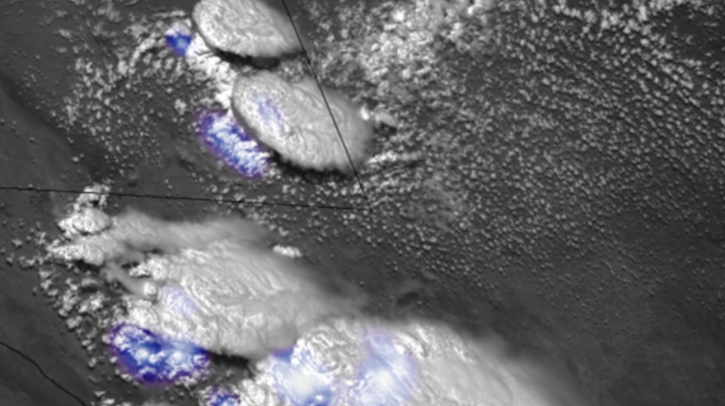Researchers at the Penn State Institute for Computational and Data Sciences (ICDS) have launched a research project to better understand and predict extreme weather events on both Earth and Mars, using computational tools and insights from traditional meteorology and funded by a three-year, US$973,396 grant from the US National Science Foundation (NSF).
The research is being led by Steven Greybush, Penn State Institute for Computational and Data Sciences (ICDS) co-hire and associate professor of meteorology, and co-lead investigator David John Gagne at the National Center for Atmospheric Research (NCAR). Their teams received one of 20 awards made by NSF to support artificial intelligence (AI) advancements in geosciences.
AI-powered weather research
The project specifically focuses on using deep learning, a type of artificial intelligence (AI) that can extract spatial patterns from image data, to predict which cloud systems develop into thunderstorms – a process known as convection initiation. They will also investigate why their machine learning (ML) approach predicts what it does and how much the researchers should trust the prediction, a technique known as uncertainty quantification.
The research team will use data sets containing satellite images representing the thickness of a cloud, the temperatures at its top or the amount of atmospheric moisture it contains which are labeled as forming or not forming a thunderstorm within the next hour. After training on many thousands of such images, researchers said their algorithm will learn to differentiate the two outcomes and be able to determine if clouds in brand-new satellite images could grow to be thunderstorms.
“Obtaining observations and making sense of our results from computer simulations is really important,” Greybush said. “It’s important to understand what we’re learning from these simulations and to compare that to theory and hopefully advance the understanding and the theory of atmosphere.
“ML is also a computational tool that is data driven; we want to be able to understand what we are looking at in the data when we make a prediction, so we use explainable AI to get physical insights that we can compare back to and perhaps advance the traditional understanding of meteorology.”
Ultimately, the researchers aim to develop AI that can more accurately predict thunderstorm formation and explain how thunderstorms occur. Their work may also broadly improve numerical weather prediction’s ability to help understand and process current weather observations to forecast future weather.
“The cutting-edge research we are doing is made possible through high-performance computing,” Greybush said. “With computers like ICDS’s Roar, we can run high-resolution simulations and many copies of them so we can understand how confident we are in the predictions. We are also able to run our data assimilation – combining simulations with real-world observations – and AI algorithms there.”
The project is expected to benefit ongoing work by the Penn State Center for Advanced Data Assimilation and Predictability Techniques, which is involved in the NOAA’s new multi-university data assimilation consortium. The NOAA CADRE consortium aims to improve weather forecasts using NWP systems.
Extreme weather on Mars
This project may also provide insights on how to better incorporate AI methods into Greybush’s other research, including Mars atmospheric predictions and winter weather forecasts. Greybush first started working with NASA as a graduate student at the University of Maryland in Washington, using data assimilation in combination with spacecraft observations to investigate what weather conditions cause Mars’s dust storms.
These dust storms affect Mars missions as they can last for weeks to months, covering huge swaths of the planet, according to Greybush, who noted that they’ve both helped and led to the demise of recent missions.
“We have reconstructed Mars atmosphere weather for the past more than a decade,” Greybush said, explaining that they use tools developed for Earth weather predictions to understand the red planet. “That has us questioning some of the assumptions we make for Earth, as well as allowing us to see how well the insights we have gained for Earth apply to other worlds.”
Predicting winter storms with deep learning
Greybush’s group also uses winter storm observations made on Earth by the NASA IMPACTS field campaign mission to improve prediction for extreme weather events such as blizzards.
“I simulate winter storms with computers to better understand why some storms are very predictable and why others are very challenging to predict,” Greybush said. “For example, you might get a snow forecast for anywhere from 5in to 25in of snow; why is that the case? What can we do to reduce that uncertainty and how can we better improve forecasts for East Coast winter storms?”
According to Greybush, having a better understanding of the forecasts is important for decision making processes across the weather enterprise and the economy.
“We are learning to better communicate uncertainty and how to handle a scenario when a low-end event might mean it’s safe to continue as normal, whereas a high-end event, even with low probability, might present danger,” Greybush said. “We are working to accurately simulate the plausible forecast probabilities, and then communicate how the two different scenarios could impact people, as well as how people can best prepare themselves.”
Greybush celebrates the various resources at Penn State that allot opportunities for expansive collaborative research projects that honor the interdisciplinary mission of the university.
“Penn State has one of the top meteorology programs and I had a great experience with the quality of the program and the instructors as a student. Now, as a faculty member, there have been great opportunities to explore interdisciplinary projects with my meteorology colleagues as well as co-hires through ICDS,” Greybush said.
“One of the strengths of ICDS is that there are many researchers working on many different application areas, but we have a lot of methodologies in common. We will be able to gain insights from working together and strengthen our own work through these interesting conversations and collaborations.”
In related news, the China Meteorological Administration (CMA) has implemented two AI-powered echo forecasting systems nationwide. Click here to read the full story.



